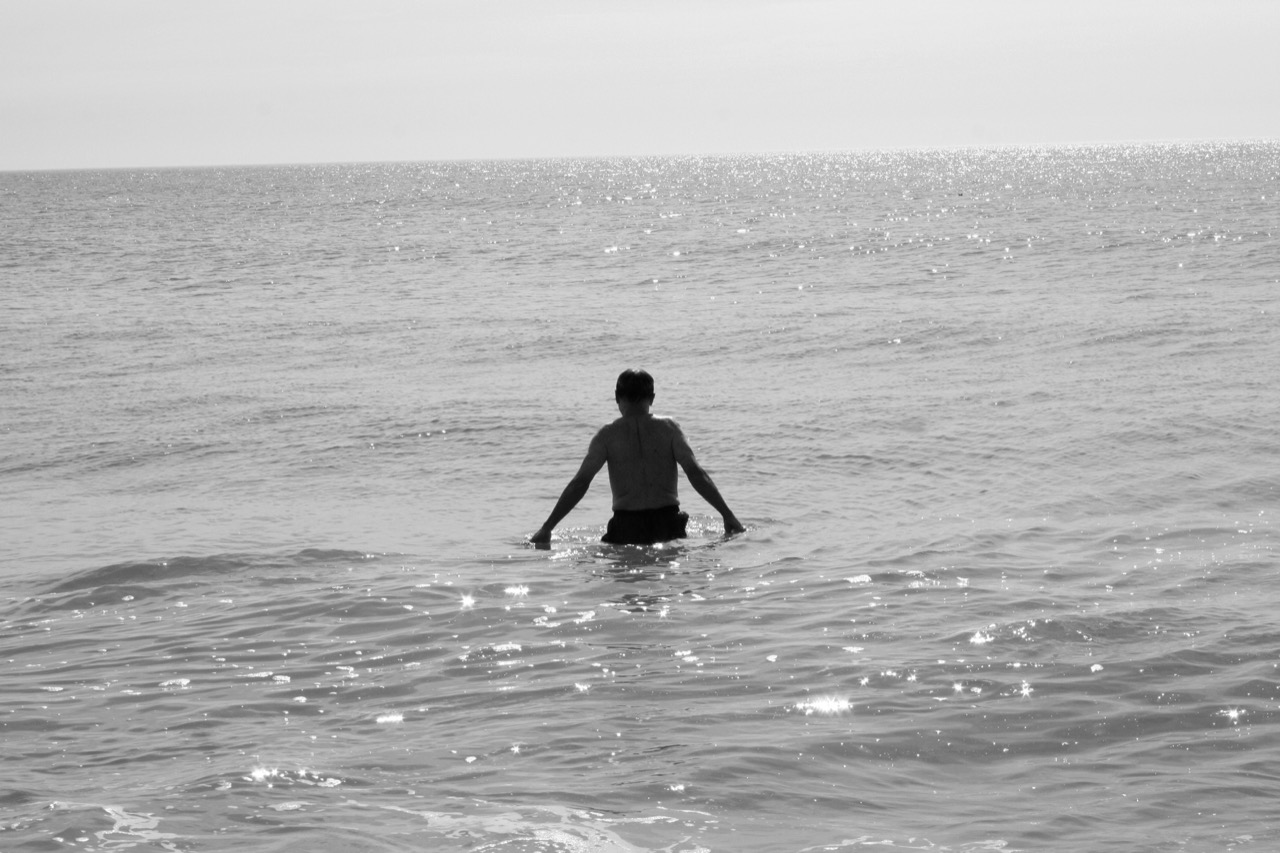Photo by Suzanne Kreiter
[ID: Black & white photo of an elderly man waist deep in the Atlantic Ocean. It’s a sunny day. His back is to the camera with his arms lifting slightly away from his body.]
At 96, my father swims 4 times a week. He doesn’t just walk through the pool, feet on the ground, like the other elders. He gives his full weight to the water. Moves like a slow fish, breast stroking and head under. Before swimming there was tennis, almost daily, till he was in his 80s and he could no longer see the ball.
People describe swimming and tennis as lifelong sports. I think of contact improvisation this way as well. Maybe not so much the sports part, as CI lives in my body as an artistic practice. But its physicality will, I hope, ease me down the elders’ road in my next few decades.
It’s been 38 years of practice for me, with significant comings and goings from the form, but also consistent and delightful returns. The covid pandemic took us all out for a while of course. The current, post-pandemic reboot has brought new thoughts to my practice, for how contact improv matters.
CI matters as a carnival ride, inlaid into deep human connection. CI matters because of the warrior efforts that have been brought to the form by people like Ronja Ver, Jun Akiyama, Mayfield Brooks and Kathleen Rea, to transform contact culture into 21st century equity. CI matters because of the commitments by dancers who show up to the jams week after week after week to practice joy, connection, and to deepen their skills. CI matters because of the organizers who labor for no compensation, to create community cohesion. CI matters as a strange and weird phenomenon, when measured against mainstream social norms for touch. But it’s worth the trouble, as its oddities enliven, and expand how we can activate touch.
Recently, in my day job as a teaching artist, I worked with Joanna Haigood/ ZACCHO on a project educating Black youth in San Francisco’s Bayview about the origins of hip-hop in the Bronx. Students learned how housing scarcity, the building of a road, widespread landlord arson and infrastructure disinvestments led Black teenagers to scratching, b-boying and b-girling, graffiti on the trains, and political messaging inside rhymes.
It’s always been striking to me that the rise of hip-hop and the creation of contact improvisation happened at roughly the same time. They’ve both become international movement languages that live on nearly every continent. The two forms could not be more different in origin, if one looks through the prisms of privilege, race, and resource access. 50 years in, hip-hop has become commercialized. CI has not. Hip-hop has permeated into almost every culture. CI has not. But I appreciate that their origin stories sit side by side in the American history of the 1970s.
Last week I was at a contact Jam at the Finnish Hall in Berkeley, deeply immersed in a dimensional dance with one of my favorite dance partners. In our travels around the dance floor, we ended up next to a young dancer grooving out with popping and house moves busting from his body with exquisite clarity. This was a full circle moment for me. That a hip-hop mover chose to bring his practice inside Finn Hall’s CI jam space, proximate to touch, integrating with touch. I’m excited to imagine where this can go, if and as dancers blend their body knowledge into potential new form.
2024 has brought me back to teaching CI more consistently. My son is 19 now and has left for college, giving me access to more open space and time. As I return to the work of teaching CI, I am thinking about new ways to integrate the technical demands of the form, the socio-emotional aspects of working body to body, and the puzzles the form gives us.
I’ve been privileged to study Steve Paxton’s puzzles, rolling on down the dance floor in spirals and 360-degree circling. Steve passed on recently, and left his legacy in bodies around the globe. When I think about his puzzles now, I’m contemplating the constant fitting together of weight, consent, motion and the unknown. I’m thinking about how to travel in the dance; how to breathe; how to acknowledge harm done in the practice of the form around gender and power; how to advance communication while still leading with unpredictable pathways, and with mystery. I’m thinking about how to value both care and risk. How to invite racial difference into the room without tokenizing it. How to embed gender expansion into how we see and celebrate another body.
In my return to teaching, I am gravitating toward simplicity. Last week I led a room full of dancers standing back-to-back, connecting top of skull down to the coccyx. Then sliding the point of contact, one dancer slipping one center of gravity under another, so someone could leave the ground and enter exquisite suspension. There was a radical moment of commitment and elation in the room, in real time, as feet dangled. It was an essential moment that carried us forward and led to inversions and falling in the next part of class.
It’s an intriguing time to be a dancer. It’s a compelling time to gather with other dancers. It’s my honor to teach what I can. It’s the swimming pool and the tennis court, as my body ages and still has wisdom in it, and unsullied will.
This article appeared in the Spring 2024 issue of In Dance.


